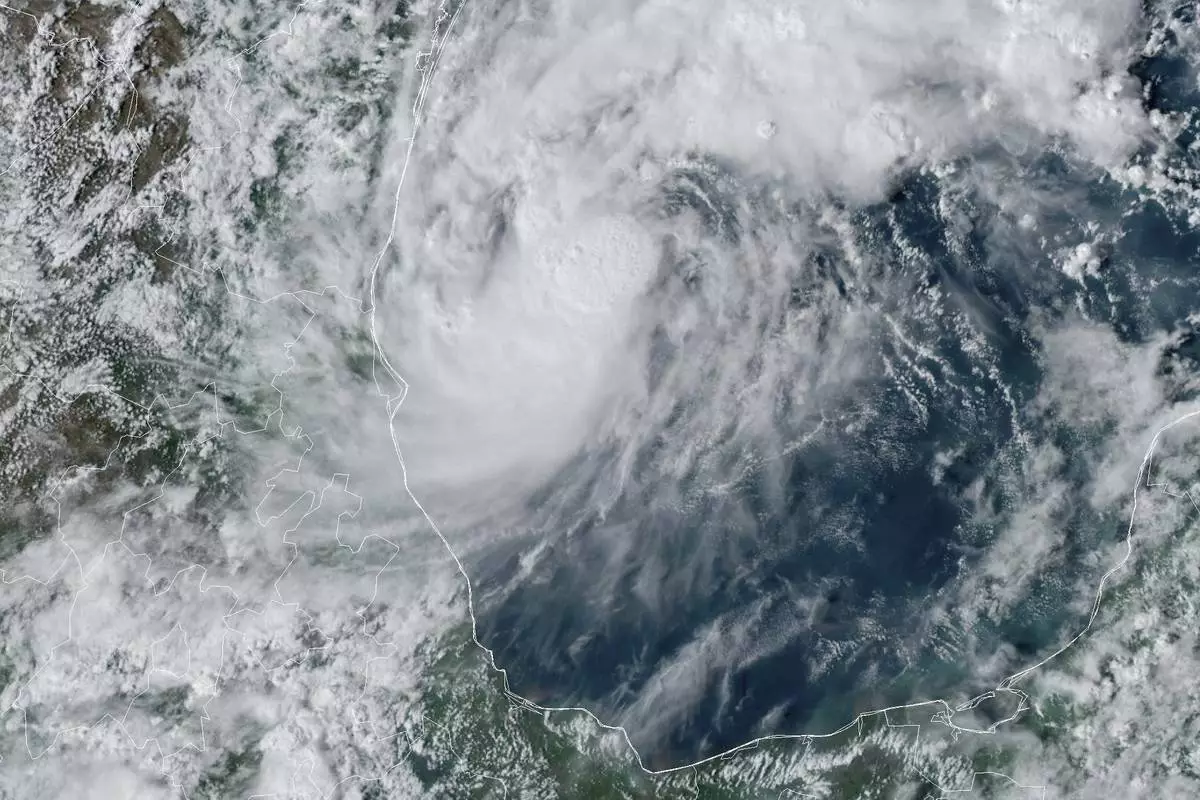Members of Arizona’s congressional delegation introduced legislation Monday that would authorize a water rights settlement with three Native American tribes in the Southwest, providing more certainty for the arid region.
The proposal carries a price tag of $5 billion — larger than any such agreement enacted by Congress.
Democratic U.S. Sen. Mark Kelly of Arizona said the legislation marks a historic step forward in resolving what has been a decades-long dispute with the Navajo Nation as well as the Hopi and San Juan Southern Paiute tribes.
The legislation would ratify a settlement agreement that was approved by each of the tribes in May. In all, the tribes would be guaranteed access to more than 56,000 acre-feet of Colorado River water along with specific groundwater rights and protections. The legislation also would establish a homeland for the San Juan Southern Paiute Tribe.
The funding included in the legislation would be distributed to special trust funds to pay for building and maintaining water development and delivery projects, including a $1.75 billion distribution pipeline.
"Securing water rights for these tribes upholds their sovereignty and lays the path for their growth and prosperity through increased investment in water infrastructure,” Kelly said.
Democratic U.S. Rep. Raul Grijalva of Arizona said the federal government's obligation to the tribes to provide drinking water could not be more pressing as climate change exacerbates what he referred to as a multigenerational drought.
For the San Juan Southern Paiute, tribal President Robbin Preston Jr. said the opportunities that would come from the legislation would be life-changing for his people.
“With reliable electricity, water and housing, our people will have opportunities that have never been available to us before,” he said in a statement. “This legislation is more than a settlement of water rights, it is the establishment of an exclusive reservation for a tribe that will no longer be forced to live like strangers in our own land.”
While efforts to negotiate an agreement have been generations in the making, tribal leaders have said the ongoing drought and the effects of the coronavirus pandemic were among the challenges that drove the latest round of talks.

FILE - A windmill draws water for livestock in Leupp, Ariz., on the Navajo Nation, March 9, 2024. Members of Arizona’s congressional delegation introduced legislation Monday, July 8, 2024, that would authorize a water rights settlement with three Native American tribes in the Southwest, providing more certainty for the arid region. (AP Photo/Felicia Fonseca, File)
MIAMI (AP) — People across Florida were given notice Sunday that Hurricane Milton is expected to intensify rapidly into a major hurricane before slamming midweek into the storm-ravaged Gulf Coast.
While forecast models vary widely, the most likely path suggests Milton could make landfall Wednesday in the Tampa Bay area and remain a hurricane as it moves across central Florida into the Atlantic Ocean, forecasters said. That would largely spare other southeastern states ravaged by Hurricane Helene, which caused catastrophic damage from Florida into the Appalachian mountains and a death toll that rose Sunday to 230 people.
Florida Gov. Ron DeSantis said Sunday that while it remains to be seen just where Milton will strike, it's clear that Florida is going to be hit hard — “I don't think there's any scenario where we don't have major impacts at this point.”
“You have time to prepare — all day today, all day Monday, probably all day Tuesday to be sure your hurricane preparedness plan is in place,” the governor said. “If you’re on that west coast of Florida, barrier islands, just assume you’ll be asked to leave.”
The St. Petersburg-Tampa Bay area is still cleaning up extensive damage from Helene and its powerful storm surge. Twelve people perished as Helene swamped the coast, with the worst damage along the narrow, 20-mile (32-kilometer) string of barrier islands that stretch from St. Petersburg to Clearwater.
DeSantis expanded his state of emergency declaration Sunday to 51 counties, and said Floridians should prepare for more power outages and disruption, making sure they have a week's worth of food and water and are ready to hit the road. The Federal Emergency Management Agency, meanwhile, coordinated with the governor and briefed President Joe Biden Sunday on how it has staged lifesaving resources.
“I highly encourage you to evacuate” if you're in an evacuation zone, said Kevin Guthrie, executive director of the Florida Division of Emergency Management. “We are preparing ... for the largest evacuation that we have seen, most likely since 2017, Hurricane Irma. ”
The state has prepared emergency fuel sources and EV charging stations along evacuation routes, and “identified every possible location that can possibly house someone along those routes,” Guthrie said. People who live in homes built after Florida strengthened its codes in 2004, who don't depend on constant electricity and who aren't in evacuation zones, should probably avoid the roads, he said.
All classes and school activities in St. Petersburg's Pinellas County preemptively closed Monday through Wednesday as Milton approached, and the Tampa opened city garages for free so people could park their cars safe from the next floodwaters.
As many as 4,000 National Guard troops are helping state crews to remove debris, DeSantis said, and he directed that Florida crews dispatched to North Carolina in Helene's aftermath return to the state to prepare for Milton.
“All available state assets ... are being marshaled to help remove debris,” DeSantis said. “We're going 24-7 ... it's all hands on deck."
FEMA Administrator Deanne Criswell defended her agency's response to Hurricane's destruction after Republicans’ false claims, amplified by former President Donald Trump, created a frenzy of misinformation across devastated communities.
“This kind of rhetoric is not helpful to people and it’s really a shame we’re putting politics ahead of helping people,” Criswell told ABC’s George Stephanopoulos. It's created fear and mistrust among residents against the thousands of FEMA employees and volunteers on the ground across the southeast, she said.
Despite this, Criswell said the agency is already preparing for Milton, well before it's clear exactly where it will move across the Florida peninsula this week. “We’re working with the state there to understand what their requirements are going to be, so we can have those in place before it makes landfall,” she said.
Federal disaster assistance has surpassed $137 million since Helene struck more than a week ago, one of the largest mobilizations of personnel and resources in recent history, FEMA said Sunday.
Nearly 7,000 personnel from across the federal workforce have been deployed, and the agency has shipped more than 14.9 million meals, more than 13.9 million liters of water, 157 generators and more than 505,000 tarps, along with approving more than $30 million in housing and other types of assistance for over 27,000 households.
More than 800 people unable to return home are staying in lodging provided through a FEMA sheltering assistance program, and while shelter numbers decline, 22 shelters are still housing nearly 1,000 people as mobile feeding operations continue to help survivors. The response to Helene will continue during Milton and its aftermath, FEMA said, saying the agency has the capacity to address multiple disasters simultaneously.
The hurricane center said Mexico’s Yucatan peninsula, the Florida Peninsula, the Florida Keys and the northwestern Bahamas should monitor the system’s progress. Heavy rainfall was expected Sunday ahead of the storm itself, and will likely then combine with Milton's rainfall to flood waterways and streets in Florida, where forecasters said up to a foot (30 centimeters) of rain could fall in places through Wednesday night.
Meanwhile in the open Atlantic, Hurricane Kirk diminished to a Category 2 hurricane on Sunday, with top winds of 105 mph (165 kph), sending large swells and “life-threatening surf and rip current conditions” to Bermuda and northward along the U.S. and Canadian coasts, the center said. Hurricane Leslie was also moving over the Atlantic Ocean, well away from land, with top winds of 85 mph (140 kph).

This GOES-16 GeoColor satellite image taken at 4:50 p.m. EDT and provided by National Oceanic and Atmospheric Administration (NOAA) shows Tropical Storm Milton, center, off the coast of Mexico in the Gulf of Mexico, Saturday, Oct. 5, 2024. (NOAA via AP)











